“If that man is not crushed before spring, he will become the most formidable enemy America has…”
George Washington, 1775.
‘That man’ was John Murray, fourth Earl of Dunmore, last British Governor of Virginia and a key if unwitting catalyst of the endgame in the stand-off between the British Crown and American Patriots, which led to American Independence.
George Washington’s outrage was caused by Dunmore’s proposal to arm loyalist slaves in return for their liberty. Dunmore had both swept aside the careful negotiations between Crown and colonies, and united North and South in defence of their social and economic structure.
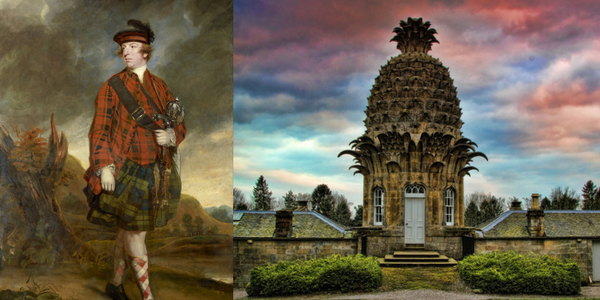 John Murray, fourth Earl of Dunmore, painted in traditional Scottish garb by Joshua Reynolds in 1785. On right right is The Pineapple near Stirling, photographed by Sally Sallet from Pineapple Pix
John Murray, fourth Earl of Dunmore, painted in traditional Scottish garb by Joshua Reynolds in 1785. On right right is The Pineapple near Stirling, photographed by Sally Sallet from Pineapple Pix
Dunmore was also the builder of one of Landmark’s most iconic buildings, The Pineapple near Stirling in Scotland. This prickly stone fruit was an addition to a pre-existing pavilion dated 1761, in the walled garden at Lord Dunmore’s estate at Elphinstone. The fruit had been adopted as a symbol of hospitality in the 18th century, and it has always been said that when Dunmore returned in disarray from Virginia early in 1777, he cocked a snoot at the world with this flamboyant folly.
Tensions between London and the thirteen American colonies had been simmering throughout the 1750s and 1760s. After Charles II’s restoration, parliament claimed the right to control trade with the colonies and to tax their imports and exports. Yet ‘no taxation without representation’ had long been a key principle in Britain, fought for in the English Civil Wars in the 1640s and enthroned anew in the 1689 Bill of Rights after the Glorious Revolution.
Far away in America, the colonists had no such representation in parliament and believed their rights as Englishmen were being denied. Taxation became a grievance uniting both the more militant New England seaboard colonies and the otherwise loyalist Anglican southern colonies of Virginia and the Carolinas. The ownership of African slaves was something else the colonies all had in common.
Lord Dunmore, meanwhile, was appointed Governor of Virginia in September 1771. He did all that he could to avoid the office. “Damn Virginia,” he wrote. “Did I ever seek it? Why is it forced on me?” He tried to have his appointment changed on the grounds that the climate was unhealthy and the social life inferior, but he did not succeeded. When Dunmore convened the colonial House of Assembly in March 1773, he promptly dissolved it for proposing a committee of correspondence on colonial grievances.
Then, in May, news came from London of the Tea Act, requiring the colonies to buy their tea only from the financially troubled East India Company. This tipped the colonists into direction action – a whole consignment of tea was dumped into Boston harbour in December 1773, an event later known as the Boston Tea Party.
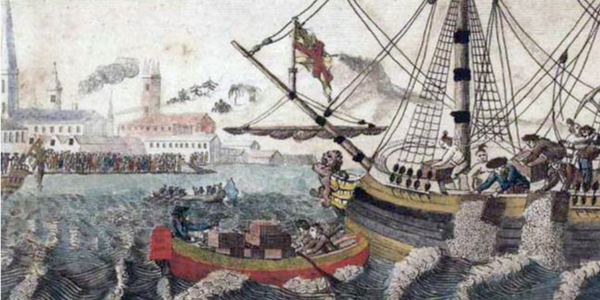 The Boston Tea Party. Image: Niday Picture Library
The Boston Tea Party. Image: Niday Picture Library
When news came in early April 1775 of an Act to seal the port at Boston until restitution of the duties was made, the House of Assembly at Williamsburg voted to set aside a Day of Fasting, Humiliation and Prayer in support of their fellow colony. Incensed, Lord Dunmore promptly dissolved the Assembly and, on the night of 20 April 1775, he clandestinely ordered barrels of gunpowder from the powder store in Williamsburg to be carried to HMS Fowey, anchored off Yorktown. It was, he wrote to London, “prudent to remove some Gunpowder which was in a magazine in this place, where it lay exposed to any attempt that might be made to seize it.”
News of the move caused immediate uproar across the colony. Marching to the city, 150 men demanded the return of their powder or settlement, dispersing only when Dunmore complied with a bill of exchange for £330.
It was in these hectic days that a group of slaves came to the Governor’s residence asking for arms so that they might fight for the Crown, in return for their liberty. Dunmore, who owned 56 slaves himself, affected horror and told them “to go about their business.” But the seed was sown. News arrived of the defeats of British troops by ragtag colonial militias at the Lexington and Concord; the revolutionary War of Independence had begun.
In May, Dunmore unilaterally decided to arm his own slaves “and receive others that will come to me whom I shall declare free”, he wrote privately. His motives, however, were not philanthropic; it was an entirely opportunistic, short-sighted initiative, a cheap gambit made in desperate circumstances. He hoped to gain an army to defend the fort until British troops arrived. Crucially, only loyalist slaves might expect their freedom.
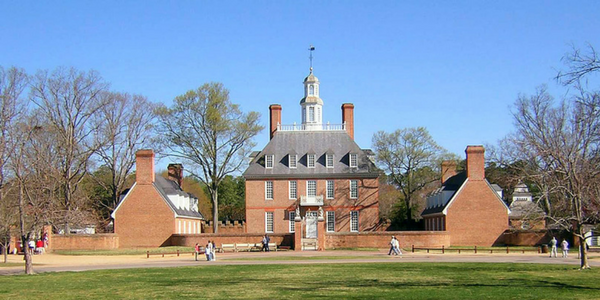 Lord Dunmore's Governor's Palace in Williamsburg was destroyed in 1781, but has now been reconstructed. Image: virginiaplaces.org
Lord Dunmore's Governor's Palace in Williamsburg was destroyed in 1781, but has now been reconstructed. Image: virginiaplaces.org
The news spread like wildfire among the slave communities – but Dunmore’s strategy instantly backfired, for it also persuaded even back-country loyalists to unite with militant Patriot leaders they had hitherto seen as hot-headed ideologues. Revolution in the South crystallized around the single, terrifying prospect of the liberation of the slave force; social necessity united the South with the North, where slaveholding was just as prevalent in enterprises other than plantations. It was now a revolution as much in defence of slavery as of colonial liberties.
In June, Dunmore fled under darkness to the Fowey. He finally set sail for New York in August 1776 and then back to London, where he simply resumed his political career in the House of Lords. A man of mediocre ability and poor judgement, he had become the unwitting patriarch of a great slave exodus.
Sadly, sources are silent on exactly when his outlandish pineapple appeared at Elphinstone. There is a local tradition that it was built by Italian workmen because the standard of craftsmanship is so high. The drainage is ingenious - the stones are graded in such a way that water cannot collect anywhere. The base of each leaf is in fact higher than it appears when viewed from below, so that the rain water drains away easily from these higher parts.
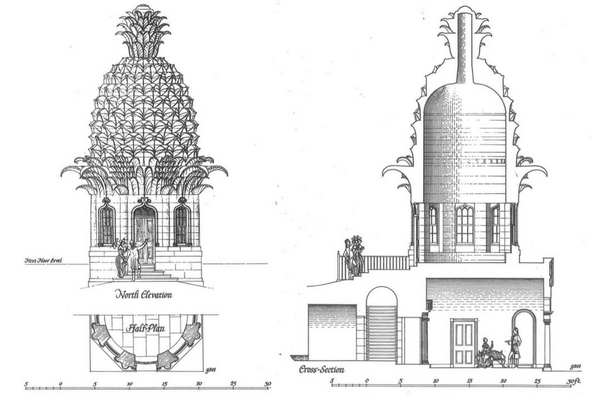 Schematics of The Pineapple. Image: RCHM (Scotland) Inventory of Stirling
Schematics of The Pineapple. Image: RCHM (Scotland) Inventory of Stirling
Whilst the folly itself is unique in architecture, the pineapple was a common motif of hospitality in furnishings and interiors. In Virginia, sailors returning home would often stick a pineapple or two on their gateposts to tell the community they were back and would welcome visitors. After his disastrous tenure as Governor, perhaps Lord Dunmore wanted to announce his return to Scotland more prominently.
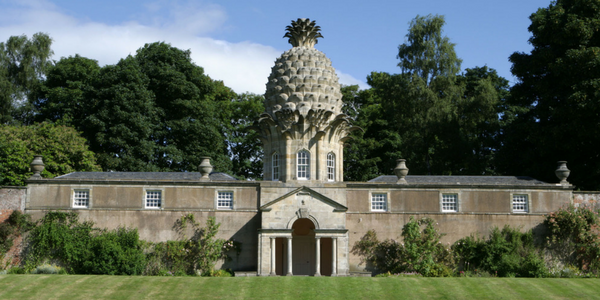 The Pineapple in all of its glory
The Pineapple in all of its glory
This is an extract from ‘Landmark: A History of Britain in 50 Buildings’ by Anna Keay and Caroline Stanford.
You can hear Caroline talking about Dunmore and his pineapple on a recent episode of BBC's Kitchen Cabinet. Click here to listen.